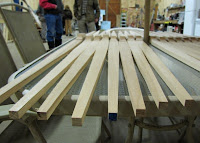As mentioned in my previous post, my mom and I attended a bow making workshop in Clark Fork, Idaho, sponsored by Twin Eagles Wilderness School.
Bow making might seem like a strange mother-son activity, but we share an interest in traditional skills. My mom has attended other workshops where she made traditional arrows with sinew, tree sap glue, and steam-straightened branches. She has also taken a class in flint-knapping. For my part, I am drawn to indigenous skills like plant medicine and pit cooking. Bow making just seemed like a natural way to connect while creating something unusual and worthwhile.
The bow making workshop was led by a team of brothers, Tim and Dan Corcoran.
At the beginning of the session, Tim read an inspirational quote from the Traditional Bowyer's Bible:
“When two or more wood bowmen find themselves together, whatever conversation ensues is largely veneer. Their most important conversation is subterranean and wordless. It’s a shared sense of the bow’s mystery, of its ties to an ancient, authentic world, of quiet kinship. Become a woodbow man and you join a band of brothers stretching back in an unbroken line to your 500th grandfather. A time when, unlike our present competitive world, your life and the life of those close to you depended on the sharing of knowledge, goods, and danger. Become a woodbow man and you see that ancient spirit resurrected, other bowmen offering you their secrets, their help, even wood and tools. And maybe more surprising, you note that without calculation or conscious will you yourself becoming such a person too. If this evokes even a whiff of primal familiarity, then it’s entirely proper that you step at least tentatively onto that ancient path: make your first bow and see what happens.”
I have to admit that the quote did stir something within me. How many generations ago did my ancestors use the bow as a primary means of survival? Considering that rifles did not become common among the Spokane until the mid-1800s, I imagine that I have a closer genetic tie to bow making than most European Americans.
The bows were made of hickory planks that were pre-cut to the approximate size and shape of a long bow. My mom was given one marked "elder" that was slightly thinner than the others, requiring less physical exertion in the later stages of bow making.
In this photograph, my mom is consulting with Dan regarding her bow.
As mentioned in another post, bow making requires a fair amount of focused attention and physical effort. We clamped the bows to a sturdy table or saw horse and then shaved away thin layers of wood using a variety of tools like rasps, knives, and cabinet scrapers. As we removed the wood, we had to constantly check to ensure that each limb of the bow maintained an equal amount of flexibility. If one limb bent more than the other, we would have to remove more wood from the stiffer limb. If a limb bent in the wrong place, we worked to correct the imbalance. The entire process requires constant attention to the smallest details.
At all stages of the process, Dan and Tim provided guidance and support.
I'm sad to say that I did not finish my bow. Even after two days, I had a few setbacks. First, I had to start over when we discovered that my original bow had several cracks. Then I used the wrong rasp for removing sufficient quantities of wood. At first, I was very disappointed, but then I realized that my commitment is simply extended beyond the weekend workshop.
My friends Graham and Ethan posed for this picture after the workshop. I'm not sure what Ethan was trying to communicate with the scowl. I think perhaps he must have felt a surge of manliness after constructing an awesome bow.
Dan posed with two brothers who participated in the workshop.
At the conclusion of the weekend, Tim and Dan gave the participants the opportunity to share parting words. After several others spoke, I said that I volunteered for the bow making workshop because it stretched me beyond my comfort zone. On many levels, this was not something I would normally do, and yet the more we stretch ourselves, the more whole we become as human beings.
In the end, Tim and Dan did more than offer a set of skills. They created a connection to our indigenous past and brought us closer to the traditional knowledge of our ancestors.
Sources:
Allely, S., Baker, T., Comstock, P., Gardner, S., Hamm, J., Lotz, M., et al. (2008). The Traditional Bowyer's Bible, Volume Four. Guilford, CT: First Lyons Press.










My Uncle, Pete Weatherford, owns Arrow Works in clark Fork : )
ReplyDelete